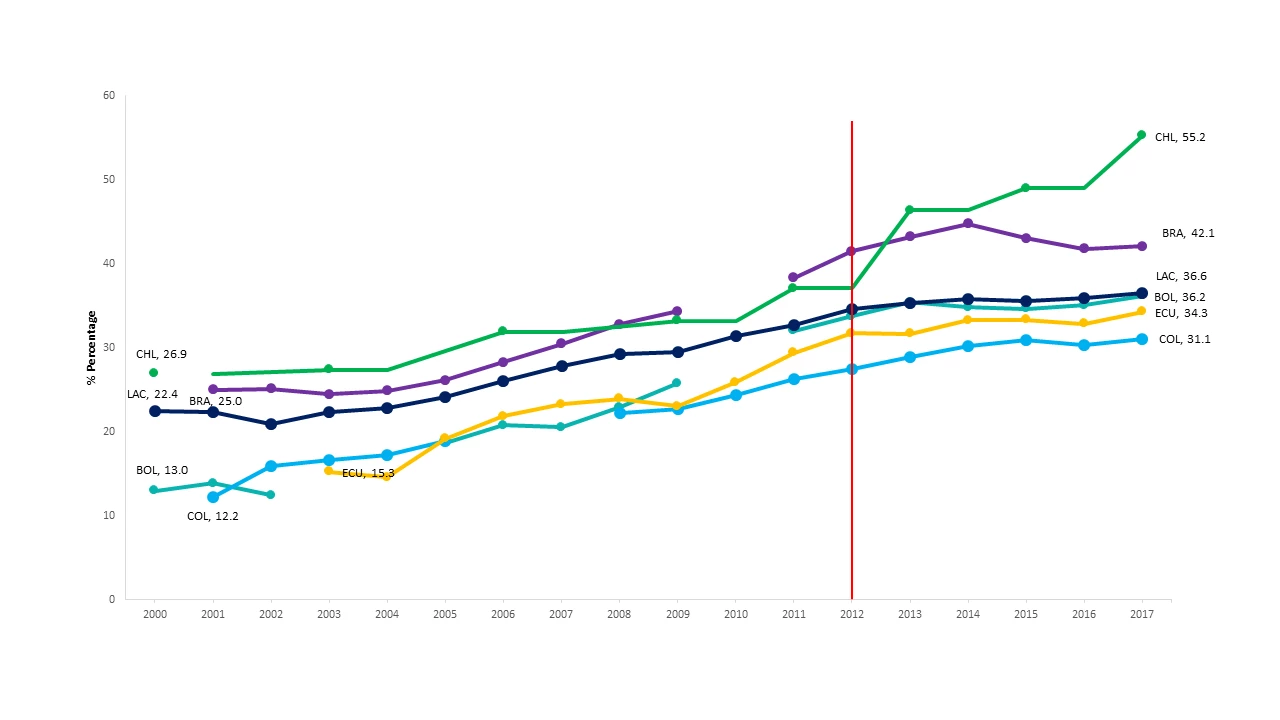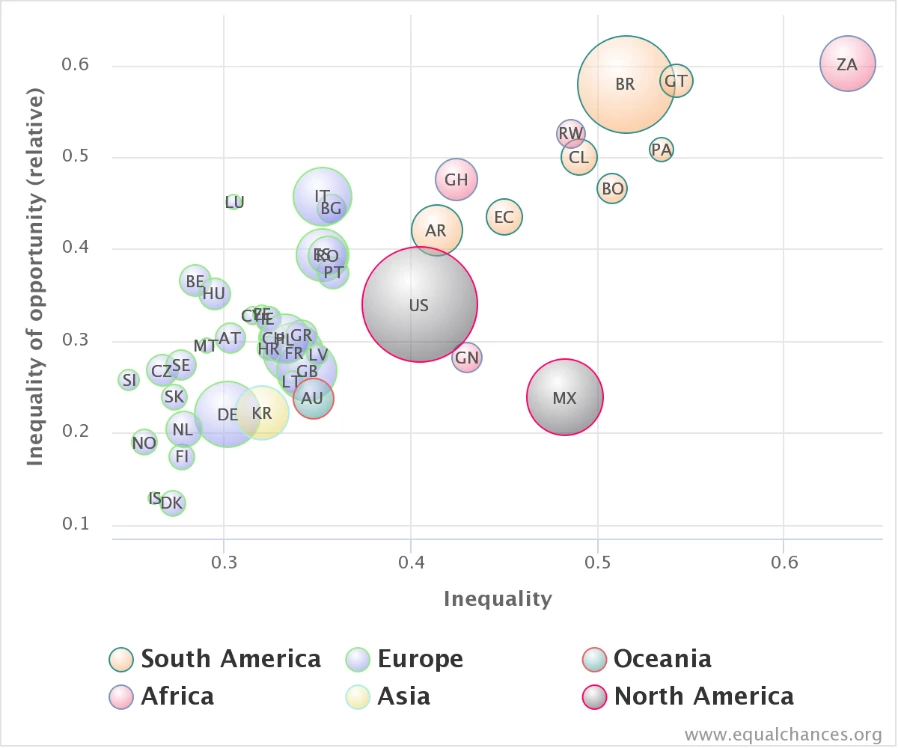 Photo: abriendomundo / Shutterstock.com
Photo: abriendomundo / Shutterstock.com
2019 was a year of turmoil. Massive popular protests rocked Hong Kong, Lebanon, Iran, and Iraq. In February three million people are said to have marched in Algeria and large popular uprisings later led to the fall of a long-standing dictatorship in the Sudan. There were protests in richer countries too: The Gilets Jaunes brought chaos to central Paris on multiple occasions. But perhaps no region saw protests as widespread as Latin American and the Caribbean, where large-scale uprisings and demonstrations took place in countries as different as Haiti and Chile, as well as in Bolivia, Colombia, Ecuador and Venezuela, among others. In Chile, Latin America’s most prosperous nation and something of a poster child of international organizations, 1.2 million people (approximately 6.4% of the country’s population) took to the streets of Santiago on October 25 – and more in other cities up and down the country.
There is clearly not a single cause for all the different protests around the world. Rebellion against – or fear of encroaching – authoritarianism clearly played a role in many cases. So did disgust at perceived corruption by governing elites. Social media clearly acted as an important facilitator. In this post, we want to comment more narrowly on two commonly proposed hypotheses linking inequality – or income distribution more generally – to the protests in Latin America and, in particular, in democratic and relatively prosperous countries such as Chile and Colombia.
The first hypothesis is that the popular uprisings in these countries represented a social response to rising income inequality. This view was particularly popular among a social media contingent who seem to believe, despite clear evidence to the contrary, that inequality is always rising everywhere. The trouble with this hypothesis is that income inequality, as captured by household surveys, has actually been declining in Latin America for the last twenty years. As Figure 1 shows, the (simple) average Gini coefficient in the region fell from 0.56 in 2000 to 0.51 in 2017 – almost a 10% decline for a notoriously sluggish indicator. Nor is this an artifact of the Gini index. Other measures agree; the p75/p25 ratio, for example, fell from 3.8 to 3.3.
Figure 1 Income inequality in selected Latin American countries, 2000-2017: Gini coefficients
To be sure, this declining trend did slow down since 2012 and has recently reversed in some Latin American countries. Figure 1 shows an increase in Brazil from 2015 to 2017, and an earlier uptick in Argentina. Unfortunately for the proponents of the simple inequality-protest link, however, there were no large-scale protests in these two countries during 2018-19. In countries that did experience mass protests (Chile, Colombia, Ecuador and Bolivia) on the other hand, inequality was either constant or continued to decline in the last few years for which data is available.
Somewhat surprisingly, this conclusion is robust to considering income trends at the very top of the distribution, which are notoriously poorly captured in household surveys. The World Inequality Database, a remarkable dataset assembled by the World Inequality Lab at the Paris School of Economics, contains estimates of top 1% income shares based on administrative tax data for five South American countries: Argentina, Brazil, Chile, Colombia and Uruguay. The only one showing an increase is the series for Argentina. The others are either stable or show a slight decline: Chile’s share goes from 0.20 in 1990 to 0.17 in 2015. Brazil’s is the highest, roughly stable around a quarter of total fiscal income. (I use the fiscal, rather than national income series, as fewer assumptions are involved in producing them.)
Let’s be clear: whether you use Gini coefficients or top income shares, these levels of inequality are obscene. A quarter of fiscal income accruing to the richest 1% of the population is clearly outrageous. Inequality in Latin America remains the highest in the world (though comparison with Africa is problematic for various reasons) and such high levels of inequality are both intrinsically repugnant and instrumentally pernicious. But that is not to say they were what brought Chileans and Colombians out into the streets. If there was a direct, simple link between high income inequality and protests in Latin America, Brazilians should have been out in the streets of São Paulo in 2019. Or Chileans in 2001. Not Chileans in 2019.
A slightly more sophisticated hypothesis linking changes in the distribution of incomes to last year’s social uprisings in the region goes as follows: Propelled by high commodity prices – and, in some cases, improved social policies – the 2002-2012 period saw a substantial decline in poverty (from 44% to 26%, at USD 5.50 per day in PPP 2011 dollars) in the region. This was accompanied by a growth the region’s middle classes, from 22% to 35% by the World Bank’s ($13 -$70 per day) definition. With the end of the commodity super-cycle around 2012 and the delayed contagion from the global financial crisis of 2008-09 finally reaching the region, both economic growth and the pace of inequality reduction slowed down – and so did middle-class growth. It was frustrated aspirations from a recently stagnant middle class, rather than higher inequality – the story goes – that led to last year’s massive street protests.
This second hypothesis is both more thoughtful and more plausible. Inspection of the middle-class trends in Figure 2 does reveal clear signs of stagnation after 2002, both for the region as a whole and for countries such as Bolivia, which did see large protests. But, alas, it does not seem consistent with the trends in Colombia and, in particular, in Chile, where the middle-class continued to grow, from 40% in 2012 to 55% of the population in 2017. (The country ranking here is affected by multiple factors, including PPP exchange rates, so focus on the time trends.) Once again, according to this hypothesis, the largest protests should have taken place in Brazil, where the deep 2014-2016 recession caused the middle class to shrink. So, at least for those two countries – Chile and Colombia – an alternative hypothesis is needed.
Figure 2 Middle class in selected Latin American countries, 2000-2017: share of population with income $13-70 (2011 PPP)
Fortunately, an eminently suitable one has been around for at least 180 years, since Alexis de Tocqueville reflected that both the French and American revolutions were born from incomplete progress, rather than from an outright failure of the preceding regime. In Democracy in America (1840) he wrote: "The hatred that men bear to privilege increases in proportion as privileges become fewer and less considerable, so that democratic passions would seem to burn most fiercely just when they have least fuel. […] When all conditions are unequal, no inequality is so great as to offend the eye, whereas the slightest dissimilarity is odious in the midst of general uniformity. […] Hence it is natural that the love of equality should constantly increase together with equality itself, and that it should grow by what it feeds on.” Or, as the Wikipedia entry on the Tocqueville Effect pithily summarizes: “as social conditions and opportunities improve, social frustration grows more quickly.”
There clearly has been socio-economic progress in Chile over the last twenty years. Poverty and inequality have fallen; access to all levels of education has grown; and average wages are higher. Social conditions and opportunities have improved for most. But the progress has been severely incomplete and insufficient – giving rise to great social frustrations. One protester, interviewed by the New York Times, came from a poor neighborhood and was the first in her family to go to college – where she even had access to a scholarship. But the scholarship was partial, and she described her student debt as a “heavy backpack”.
Tellingly, she felt that the playing field was still tilted against her: “There is this discourse of merit, of striving, of how you should get up earlier. But even if we get up early, nothing is going to change.” (Javiera López Layana, quoted in the New York Times, 3 November 2019: “'Chile Woke Up': Dictatorship Legacy of Inequality Triggers Mass Protests”). The evidence suggests Ms. López is right. Measures of inequality of opportunity – which capture how much income inequality can be attributed to factors beyond a person’s control, like race, gender, place of birth and family background – remain extremely high in Chile – and most of Latin America. Figure 3 plots such a measure against income inequality, in a version of the well-known Great Gatsby Curve. Aside from South Africa, Latin America has the highest levels of inequality of opportunity. Getting up earlier is not, in fact, enough to catch up with the elites if you are born to poorer parents and in the wrong part of town.
Figure 3 The opportunity Great Gatsby Curve
Protesters like Ms. López are emboldened by recent social gains, rather than by worsening conditions, to demand levels of fairness and equality which are still far from their reality. They demand a break with the old Latin American social contract through which elites pay lower taxes (except in Argentina and Brazil) and opt out of low-quality public services, hoarding opportunity through private schools and kindergartens, private health insurance schemes and clinics, and better pension systems than those available to most. In that sense, the 2019 protests in Chile and Colombia are related to inequality after all: inequality of opportunity preserved by an oligarchic social contract.






Join the Conversation